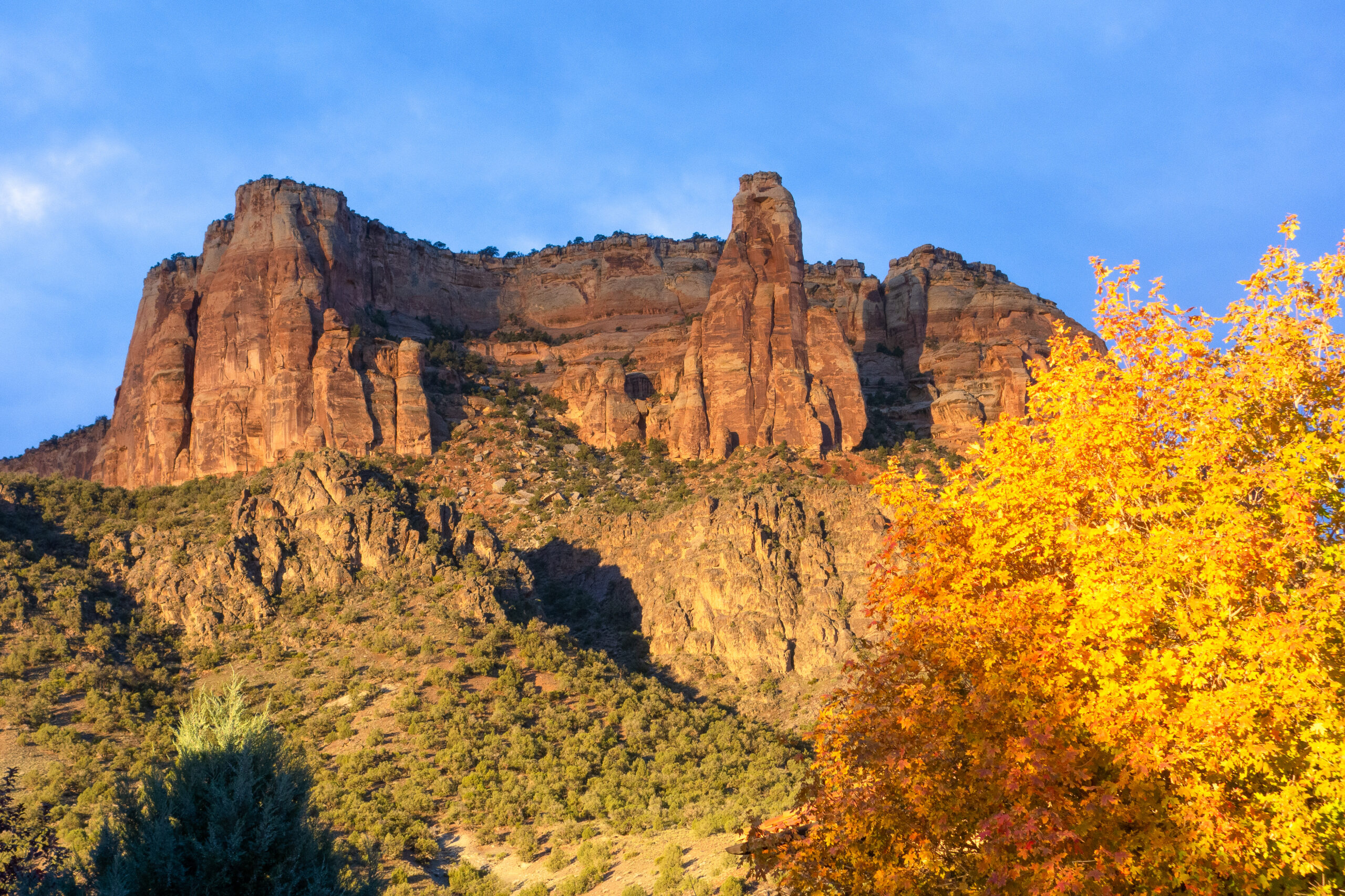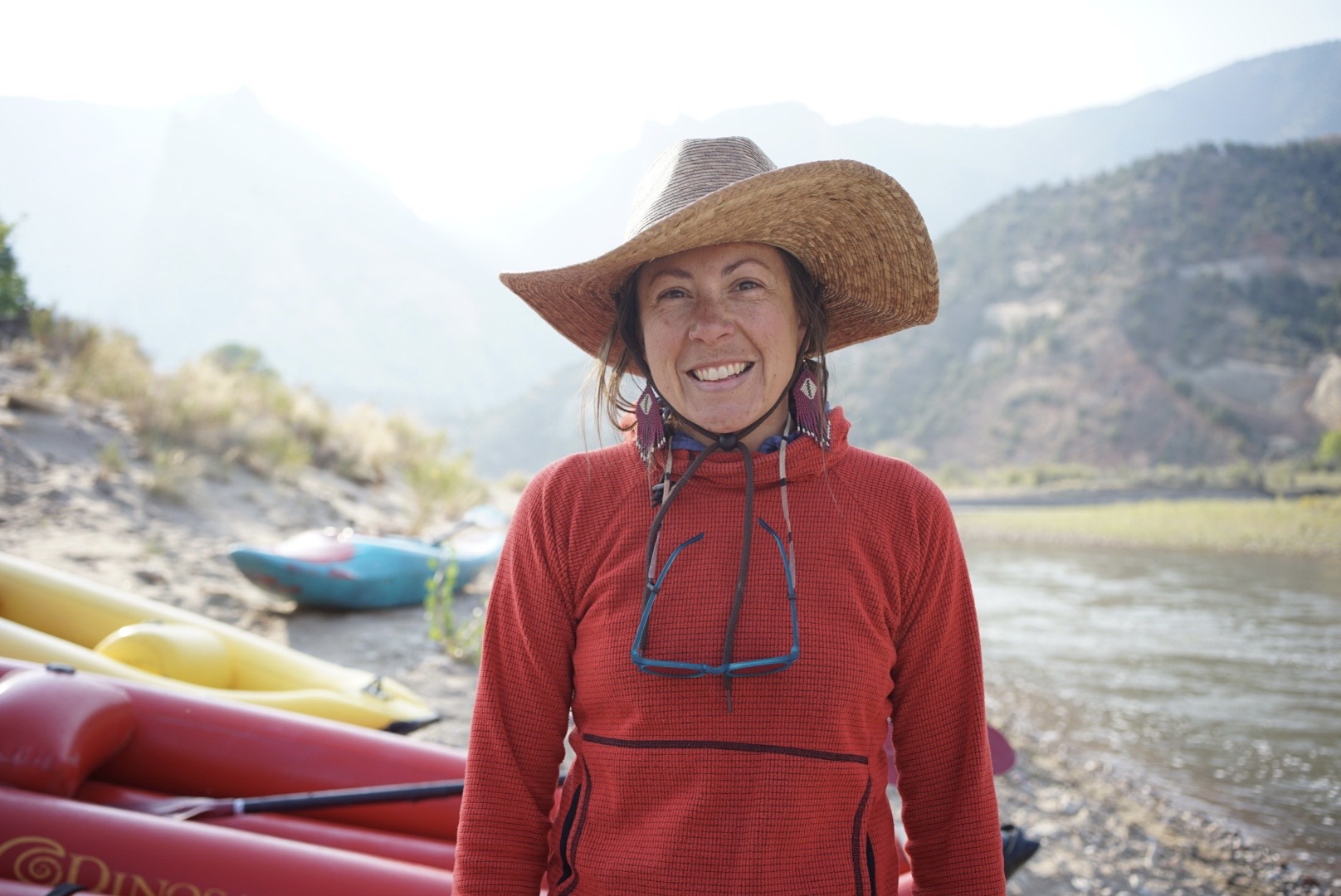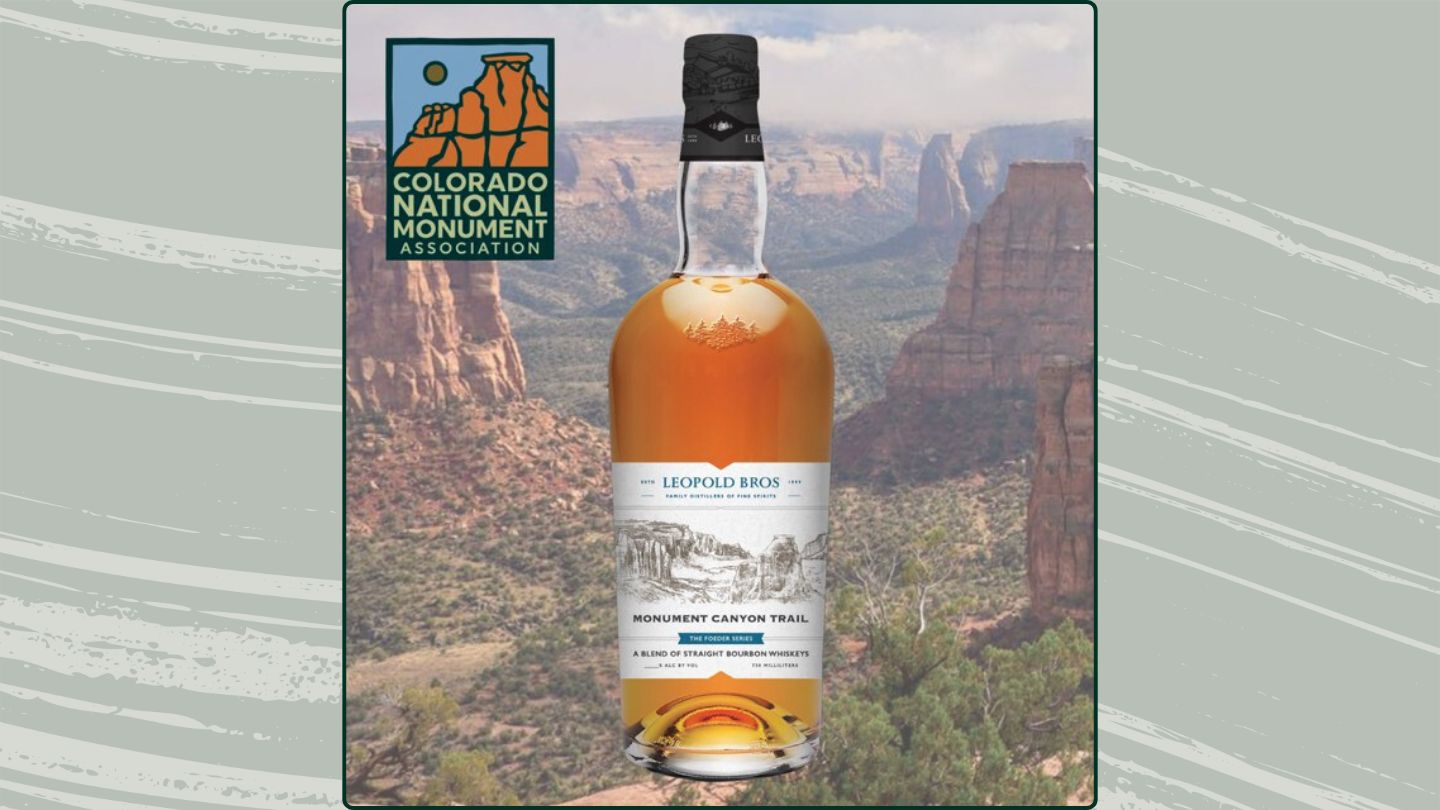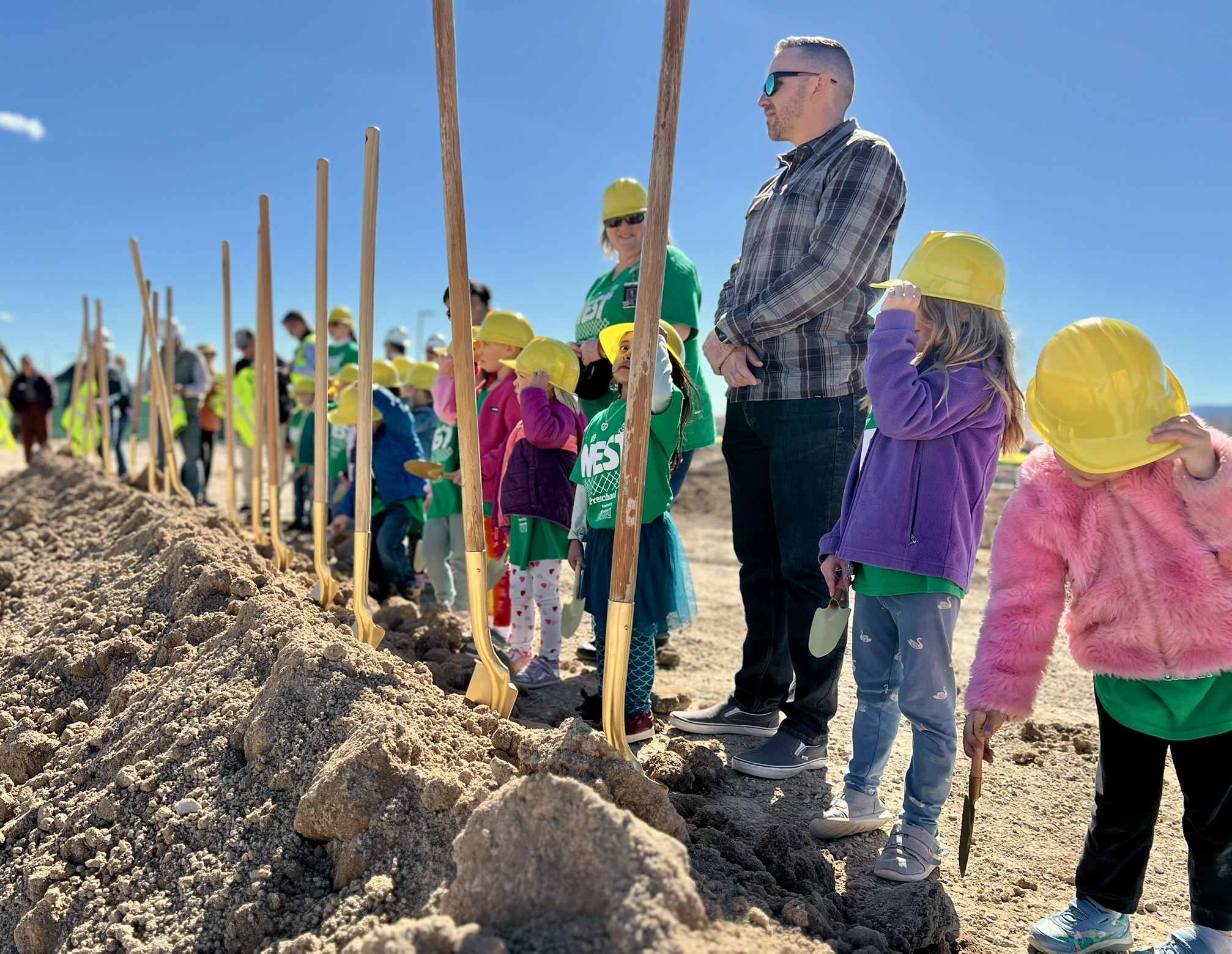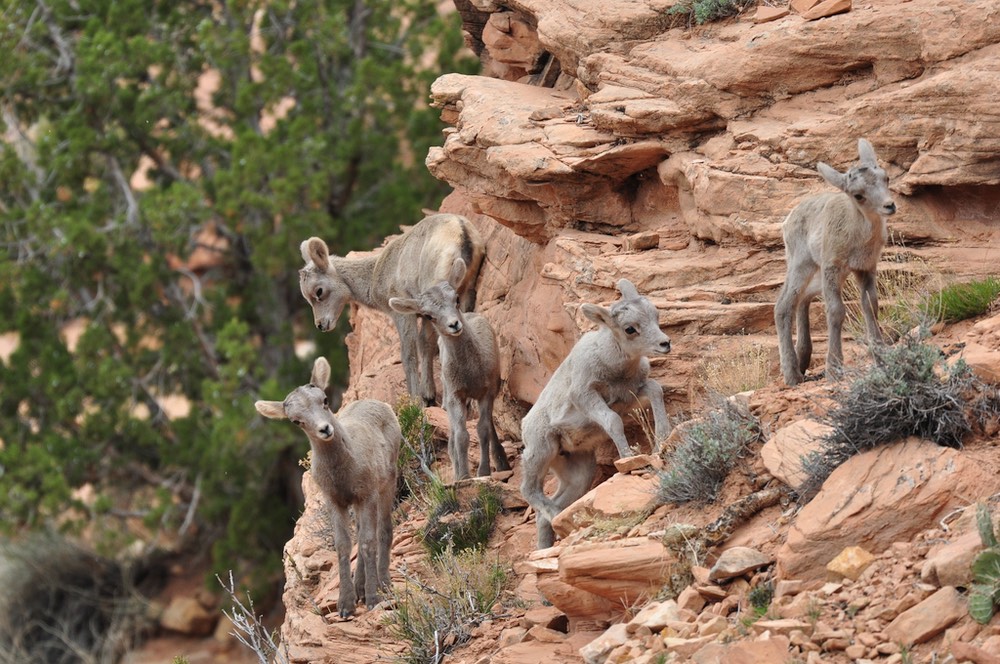05/14/2024 — Nicholas Scarborough
Sunset Reflections on Black Ridge
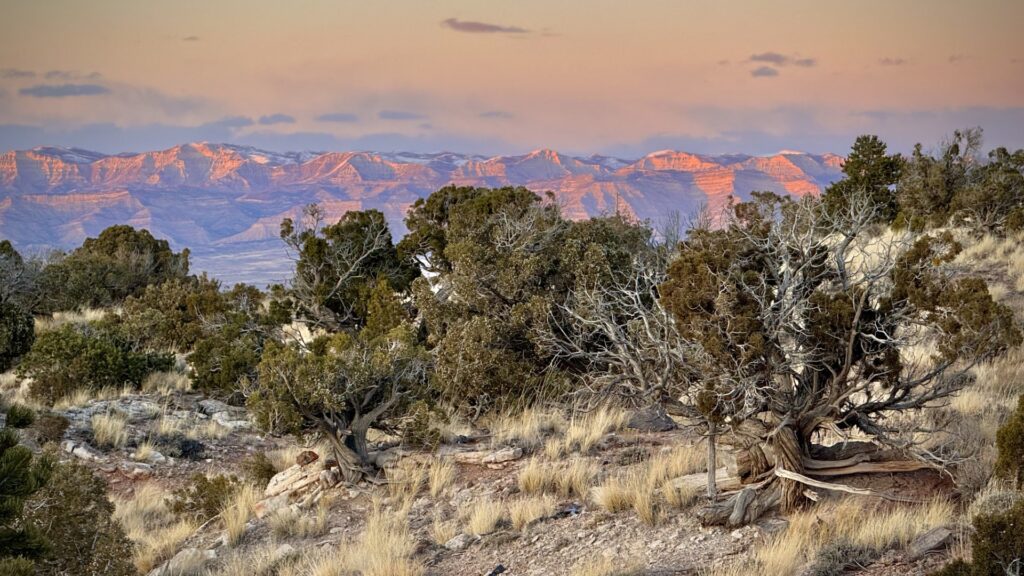
Colorado National Monument Association Member Feature by Nicholas Scarborough.
‘Sunset Reflections on Black Ridge’ captures a late winter sunset hike complete with observations about the landscape and a hiker’s place within it.
Sunset Reflections on Black Ridge | Words and Photos by Nicholas Scarborough
When I step onto a trail, I’m reminded that I’m not special. Chirps from small flocks of songbirds tell me that they are doing just fine without me there. I notice the flash of white feathers framing the tail as the little birds skip between green juniper trees. I see a yellow beak on a solid black head, with dusty gray-brown bodies. These juncos regard me as a mild intrusion to their foraging area, otherwise nothing special.
I climb the trail to a higher, flatter spot on the ridge. From here, I can see south to forested hills, a foundation of white snow between each dark green spot of individual trees; to the north, an unobstructed view across the valley in the late afternoon light. It’s nearing sunset, and a light breeze has awoken to welcome the change. The wind tousles my hair, like a familiar elder giving friendly gentle encouragement. Keep walking, there’s more to see ahead, you sweet and silly human. It’s another reminder that I’m not really special here, but I am welcome to experience what’s special about this place if I allow myself to be open to it.
Not being special feels like a relief when it’s on my own terms. I’m grateful to feel security, be safely housed, have consistent income, and know that my loved ones are taken care of. I’m grateful to not want for things like healthy food, clean water, close friendships, and respect from peers. It’s quite a privilege to step away for a while and go hike. Many might ask, very reasonably, “You have everything you need. Why would you leave that, even for an hour?” I imagine every hiker would have a unique, personal reason. Given the prerequisites and constraints, it’s a wonder that any of us hike at all, but it’s no wonder that so many of us don’t.
The trail crosses below an exposed rocky cliff. While it’s dry now, the sediments that make up this cliff face are textured like drips and waves, almost like piles of wet sand dripped from gritty fingers to form a lumpy sandcastle. Each rainstorm saturates these soils and carries some of the land with it downslope, petrifying into erroneous mud, now solid, soft, sere. The gray soil seems almost chalky, seems almost sandy. It’s a light, warm gray color, with sections of reddish tints here and there. The arid smell and drab colors stir a memory. Although I’m near the edge of the Colorado Plateau, I can imagine I’m high in a different mountain range with how rocky and barren this section of trail is.
For me, stepping onto a trail in an environment with only light human interference feels liberating. The human-built world of our everyday lives is designed for our use. Every built piece is made for us, and it’s easy to forget that people make things for people. That is, we construct things for our own use, and that makes us the special users of those things. Out here, I’m not asked to use the rocks in a certain way, the birds or trees, nothing is there to make things easier or harder on me except the trail built by humans before me. Nature is there to exist on its own, overwhelmingly neutral towards my individual presence so long as I don’t disturb it. But compile my everyday consumption of human-fashioned goods, and the planet as a system starts to care about my actions.
I remember where I am and survey the path ahead of me, surprised by the apparent lack of recent footfall. Like a wet erase board, the sandy trail of footprints resets after rain, but for the deep impressions of squelched slips in saturated sediments. Mounds and round ridges maintain their shape in the path where earlier hikers attempted to traverse the soft mud. These shapes became temporary structures in the trail after the water soaked in or evaporated out, dried into a fantastic micro-province of basin and range. Even this is not the human specialty of the trail, as hooves and paws have also dried shapes into the dirt, though admittedly with less surface area and depth.
Climbing past the broken cliff, I enter woodlands of twisting Utah juniper trees interspersed with the occasional pinyon pine. The pinyons are dressed in telltale pine needles growing in short clumps, while the junipers’ leaves are almost feathery, composed of overlapping scales – proto-feathers, if they were certain dinosaurs. Both trees are low-growing compared to trees in most other parts of the world. Here, they grow less than twice my own height, hardly providing shade for a large animal like a human. I’m clearly not meant to be special in this landscape. These woods grow for the smaller beings: the cottontails and woodrats, the pinyon jays and juncos, the collared lizards and faded rattlesnakes.
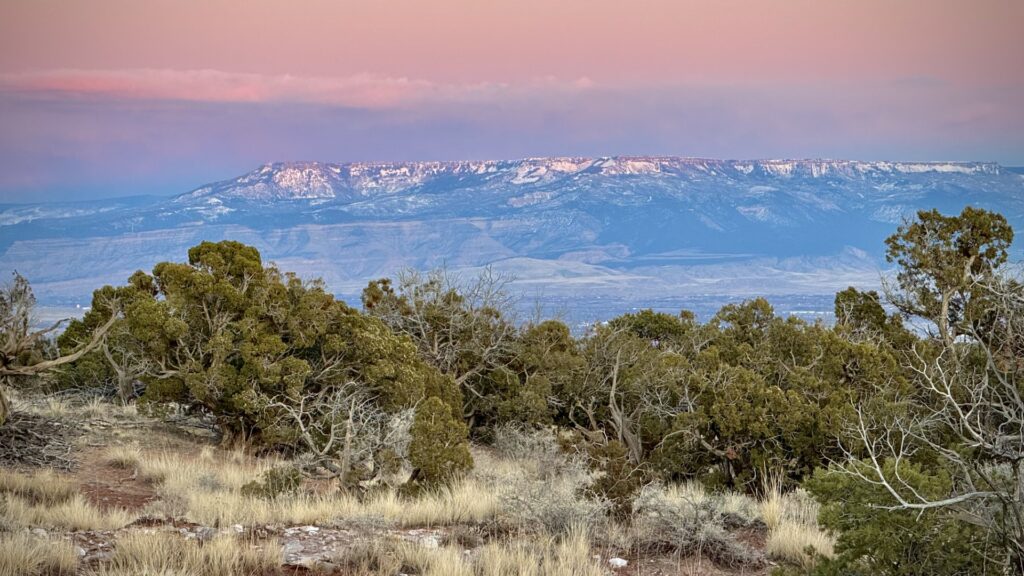
The highland I’m hiking is known locally as Black Ridge, yet there is little that seems black about this ridge to me. I could count the black parts that come to mind: chickadee and junco heads, ravens, collars on lizards, mature towers of soil crust, dormant mosses, duff beneath trees. Yet nothing black here is permanent. The birds move, lizards brumate (reptilian hibernation), soil crust matures. Even the mosses awaken to glow green with water, and the duff becomes brown when new needles fall. Perhaps it is a black ridge insofar as black is the combination of all colors, and all colors reside here. A name is only as permanent as we continue to describe it so. This area has likely had many names by humans over the millennia. I imagine the Black Ridge doesn’t mind what we call it, so long as we show it care and protection.
I’m struck by the vibrancy of color in a handful of small speckles on the ground. I stoop to see new greenery and feathery yellow flowers erupting from the desert ground. Too soon my friends! It’s a cold night yet. The mild winter has tricked many plants this year, though they rely on daylight hours as much as temperature and wetness. There’s nothing I can do for these early sprouts except wish them well. Again, I’m reminded how un-special I am to the living and non-living things here. The best thing I can do is remain a respectful visitor.
Nearing the top of the ridge, the landscape opens into rolling hills of grasses, wildflowers, and low-growing shrubs and cacti. The sun is just about to touch the horizon on this late winter day. A cloud creates a softness to the light, blanketing the muted colors of dormant plants. Last year’s flower heads reveal huge blooms, now husks in khakis, tans, and browns. I always enjoy seeing the flower remains that have persisted throughout the fall and winter. It’s the shells of abundance, a call to bounty, and I can imagine the fields coated in color. For them, I’m a passing shadow, and that’s all I need to be.
At the top, the viewshed is diverse: canyons, hills, forests, valleys, cliffs, mesas; stone, wood, grass, sky, river, cloud. The faces of the distant mountain ridges alight, signaling the last call of dusk. Crags become torches, and the valley floods with liquid blue shade. Generations of people, for millennia before colonization, received witness to the lighting of the Book Cliffs. It would be disrespectful to think that I’m special for being here; an ephemeral presence, a quiet visitor, amidst a desert rainbow.
As usual, the sky collects what colors it can from the landscape before solidifying everything into a blue-gray slate, inviting the first star of the night as a shimmering pinprick of silver. Calling such an event “usual” might be wrong though, as many will never witness such a scene in this lifetime. I don’t need to be special to this place for it to feel special to me. It feels special that I get to be here, now, observing a small slice of history on a continuous path of beauty, a cycle of destruction and construction. All is repurposed into everything else in time; may I add wellbeing and positivity into the next iteration of existence. Not special, just one of many, just me and us.
After a moment of reflection and pause for gratitude, I return downhill. I pass the expired flowers, the woodlands, the rocky soils in the light of dark blue shadow. Birds have settled for the evening, and a renewed stillness calms the landscape. A crisp chill in the air encourages me to make it back to the trailhead quickly. Only my footsteps and breath impose the quiet, and soon Black Ridge is behind me, dark but not black, to alight again at dawn.
—
We are so thankful to Nicholas for sharing this story.
If you liked this piece, you might also enjoy the rest of Nicholas’ writings about his outdoor experiences across the years. Check out his blog website The Art Outside and tap “Reveal” to read his creative writings from 2015 to 2020.
Nicholas is a Colorado National Monument Association member who came to the Grand Valley in 2021.

—
If you are interested in contributing to the Colorado National Monument Association blog, please reach out to Crystal Tyndall, Membership and Outreach Coordinator, via email – ctyndall@coloradonma.org.


